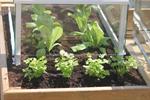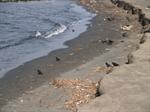
If you can get the soil right, you can have a tremendous impact upon the success or failure of the plants you grow in it. There is a huge amount to learn about soils though. Some people spend their lifetime just studying soil. You might not need to go that far; but if you can understand how soil is structured; how nutrients and water are delivered to plants; and the many factors that can cause problems with soil: you will have a foundation for achieving far more successful and profitable plant growth.
Soil erosion, which is the movement of soil particles from one place to another by wind or water, is considered to be a major environmental problem. Erosion has been going on through most of earth's history and has produced river valleys and shaped hills and mountains. Such erosion is generally slow, but the action of man has caused a rapid increase in the rate at which soil is eroded (i.e. a rate faster than natural weathering of bedrock can produce new soil). This has resulted in a loss of productive soil from crop and grazing land, a

s well as layers of infertile soils being deposited on formerly fertile crop lands, the formation of gullies, siltation of lakes and streams, and land slips. Humans have the capacity for major destruction of our landscape and soil resources. Hopefully, they also have the ability to prevent and overcome these problems.
In cases of severe land degradation the first step towards rehabilitation is identifying the problem and the underlying causal elements. Often there will be a number of contributing factors. Therefore, these factors must be neutralised or rectified in order to obtain as best as possible a complete solution to the problem. With any problem that is encountered, there is a wide range of help and advice available directly from government and other initiatives such as Landcare or Countryside Management
Erosion is nornally caused by either wind or water moving soil particles. Both can be significant; but in situations where the land is covered by dense vegetation; water erosion is more likely to have a greater impact.
Water Erosion
With water erosion, soil particles are detached either by splash erosion (caused by raindrops), or by the effect of running water.
Runoff is the term applied to the movement of water (especially rain) when flooding occurs. In the process of moving towards the line of least resistance the water builds up speed and begins to eat away at surface soil.
Several types of water erosion are common in our landscapes. These are:
- Sheet erosion where a fairly uniform layer of soil is removed from an entire surface area. This is caused by splash from raindrops, with the loosened soil generally transported in rills and gullies. It commonly occurs in areas which are overworked, such as pastures which do not get a chance to regenerate. Sheep are especially hard on pastures due to their close grazing attributes. Managed rotational grazing is advised. This may mean subdividing to reduce grazing pressure, putting cattle instead of sheep on ailing pasture or even reducing stock levels. Steep hills are also prone to sheet erosion, especially if lacking vegetation.
- Rill erosion this occurs where water runs in very small channels over the soil surface, with the abrading effect of transported soil particles causing deeper incision of the channels into the surface. Losses consist mainly of surface soil.
- Gully erosion this occurs when rills flow together to make larger streams. They tend to become deeper with successive flows of water and can become major obstacles to cultivation. Gullies only stabilize when their bottoms become level with their outlets. Management of catchment systems on farms is a vital element in controlling gully erosion. Without it unsightly and more importantly production sapping holes appear on the landscape. Soil is washed downstream with every rainfall and the gullies widen. Maintaining or developing vegetative cover is the key to correcting gully erosion. Plantings of native trees, shrubs and grasses are recommended. Stock should be excluded from access, except at designated drinking spots. Vermin, especially rabbits must be controlled as they are most destructive in terms of erosion. Certain structural works may be required, that are designed to direct or contain water flow.
- Bank erosion this is caused by water cutting into the banks of streams and rivers. It can be very serious at times of large floods and cause major destruction to property.
- Tunnel erosion - is generally associated with rabbit problems and dispersive soil types. Ripping to break down tunnels and sowing deep rooted pastures is recommended. Fence off stock, at least temporarily and control rabbits to rehabilitate affected land.
- Land slips - result from many of the factors already mentioned, also excessive clearing which leads to water-logging problems. Areas prone to slipping require re-vegetation using trees and pasture which will use excess moisture, and the establishment of effective drainage.
Where Can This Course Take Me?
The course is specifically designed for ornamental gardens, landscaping, container growing and turf situations.
- Horticulturists
- Nursery growers
- Head Gardeners
- Turf Specialists
Anyone interested in knowing more about soils and how we can use soil to benefit our landscapes and gardens without causing damage.
Learn from experts: our tutors are well-qualified in this field - they are there to help you through your course with support that rivals most other institutions.
